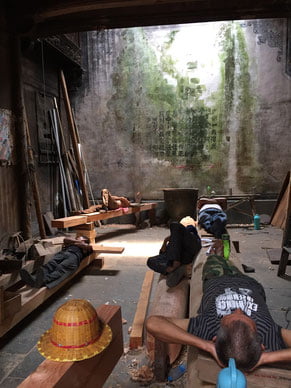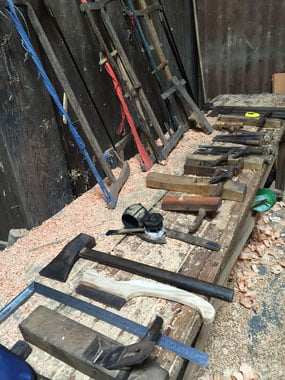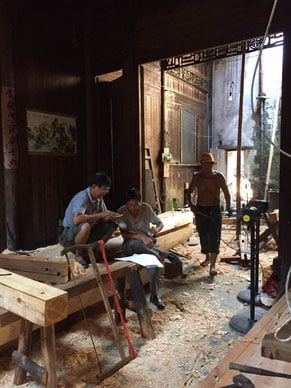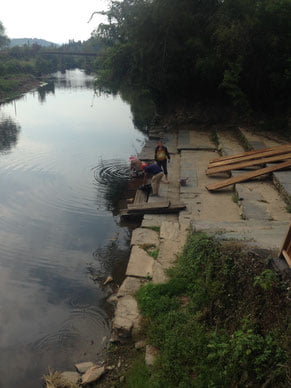
From rose gardened manors to a student tip, every house has a distinctive smell. Ours is one of fragrant China Fir wood oils. The inside is built completely from wood – the walls, the ceiling, the floors and the frame holding it up. China Fir (misleadingly a type of Cypress tree) or Cunninghamia lanceolata grows wild in the woods around the village and in the mountains beyond. It is exceptionally strong, but workable and has stood firm (give or take the odd wobble after 280 or so…) for 300 years in our house. It is most prized for its gorgeous smell, and entering our front door one’s nose could be forgiven for thinking it was in a moist woodland glade with pine cones crunching underfoot.
To help us restore the house, we’ve brought in a local team of carpenters, who are simply a joy to be around. Powered by a potent cocktail of cheap cigarettes and power naps, they work tirelessly and with precision. Their ways are the old ways, using handsaws, chisels, axes and planes – nothing is factory prepared; power tools, nails and glues are completely out of the question.



One of their first jobs was to raise the second floor roof. Originally, the second floor would be for the single women of the house to live in, out of view from the eyes of prying men. I fear 300 years ago, rural teenage girls’ frames were rather smaller than some of the guests we envisage coming to stay. This means lifting the roof two feet, which is all done with hand carved new joints, pure wood-on-wood carpentry porn. Where the original builder left off all those years ago, ours continue today. They work to the same standard, using the same techniques, with the same preposterously long saws, paint brushes and lengths of string to measure their cuts. Much knowledge was lost in the 20th Century in China, but we are blessed to have found a pocket where they live on. They are in a frail state though – young people are not interested in this line of work. The bright lights of the city are too much for most to resist, and the real money in construction is in concrete, shopping malls, shiny glass and marble floors. Grandpa may be handy with a hacksaw, but nobody below the age of 50 seems to be taking any notice.
To date, they have taken the house apart as one would a lego kit from roof to floor. Every piece of wood is inspected, repaired or replaced and put back. Sandpaper is a tool of the foreign barbarians, so each piece of wood is scrubbed by hand with water in the river. Whilst I balked at this originally, the deep caramel tone of the old wood immediately won me over. This has all gone back up and we once again have a roof over our heads, but with a sturdy, good-as-new frame, and solid floors. (I’ve given the 2nd floor the jump up and down test, passed with flying colours). The wood panelling is now going back in to form the walls and soon we shall have a Huizhou house again, ready to be modernised with electricity, water, sound proofing and cocktails. I shall be sad to see them go. Its been a pleasure to watch the experts do what they best, and I feel lucky to have caught the last generation of true artisans. If we had waited 10 years more to do our project, I am sure we would have had to take a different approach, involving nail guns, a steel frame, welding arcs and glues and would have lost something in doing so.



In any other building in China, the pervasive construction mantra seems to be: 差不多 (chabuduo), or ‘close enough’. Anyone who has spent time here will be familiar with taps that give you electric shocks, doors that neither open nor close, or a bit on the floor you all agree not to stand on ‘just in case’. When houses are built down to rock bottom prices, in batches of 10,000, such flaws are deemed ‘close enough’. (read this fantastic article for more) We are in a uniquely lucky position not to have to put up with this, having a team who takes pride in their work, only accepting a high standard that they will want to bring their grandchildren around to say: ‘I made this’.
Our door will be wide open to them whenever they do.






